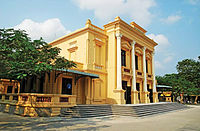Haiphong Opera House
Haiphong Opera House (Vietnamese Nhà hát lớn Hải Phòng) is a French-built neoclassical opera house on Opera Square (Quảng trường Nhà hát lớn) in Hai Phong, which was opened in 1912.[1]

History
The first performance of opera in Haiphong was held by a travelling troupe in the Hotel des Colonies in 1888.[2][3] Later 1895-1897 a touring French opera company in Indochina, featuring Alexandra David-Néel as prima donna toured Haiphong with La Traviata and Carmen.[4] Another touring company, while waiting for the 1902 Exposition of Hanoi to open, came to Haiphong, including Blanche Arral.[5]
The French colonial authorities cleared an old market in the square to make way for the Opera House which was in construction from 1904 to 1912. The French architect deliberately copied the designs and materials of the Palais Garnier in Paris. When it opened performances were put on by touring singers, alternating with performances at the Hanoi Opera House On August 23, 1945 the Opera House was venue for the first public meeting of the Viet Minh in Haiphong, followed by a march and occupation of key buildings not guarded by the Japanese.[6] The Opera House was shortly afterwards scene one of the first conflicts of the First Indochina War. On 20 November 1946, during the first days of the French attack on Hai Phong, 39 Viet Minh soldiers and Opera staff with antique muskets led by platoon commander Đặng Kim Nở fought French troops from the Opera House for three days and nights, killing 50 French soldiers before they were overcome.[7] The Viet Minh evacuated the city on the 23 November under bombardment.
Under French rule the Opera House had primarily been for the colonial population. With the departure of the French population the Opera House turned more to local genres including classical Sino-Vietnamese hát tuồng opera, classical Vietnamese hát chèo drama, and the popular cải lương folk musical, as well as Socialist theatre and musical. The Opera House also holds concerts of Vietnamese music, both classical ca trù, and neotraditional Vietnamese-Western (nhạc dân tộc cải biên, "revised national music"), folk genres such as hát chầu văn ("hát văn") and quan họ, and popular songs.
References
- Lonely Planet Vietnam - Page 136 Nick Ray, Yu-Mei Balasingamchow, Iain Stewart - 2009 "Sights & Activities Have half a day on your hands in Haiphong? There are a few low-key sights to keep you busy ... Check out the neoclassical Opera House (Nha Hat Lon; P Quang Trung) which dates from 1904, its facade embellished with ..."
- Opera: Volume 54, Issues 1-6 2003 "Opera came later to the northern part of the country, where the town of Hanoi and its port, Haiphong, never quite rivalled Saigon. In 1888 the Haakman Troupe, made up of Haakman (pianist), Madame Grausse (first singer), Mme Mercier (second singer), Ferrier (baritone) and Roger (tenor), made their debut in the Hotel des Colonies in Haiphong with programmes."
- Haakman, Jean Jacques, violinist and composer, born in 1862; died London, Feb. 4, 1931
- Alexandra David-Neel: Explorer at the Roof of the World - Page 24 Earle Rice - 2004 "At last, in the autumn of 1895, Alexandra landed a ... 31 She spent the next two years touring French Indochina, now Vietnam, appearing in Hanoi, Haiphong, and elsewhere, while performing lead roles in such operas as La Traviata and Carmen"
- The extraordinary operatic adventures of Blanche Arral Ira Glackens, William R. Moran - 2002 -"Like so many theaters in remote places, it was a small-scale model of the Paris Opera, new and with all the latest equipment for theatrical productions. It was our plan to give performances in Haiphong until such time as the International Exposition at Hanoi opened, and then to alternate between the two cities."
- David G. Marr - Vietnam 1945: The Quest for Power 1997 -- Page 404 "In a deliberate, if smaller-scale, replay of events in Hanoi four days earlier, the Haiphong Opera House provided the venue for a public meeting, followed by a march and occupation of key buildings not guarded by the Japanese."
- Insight Guides Vietnam - Page 179 2002 "During the first days of the 1946 French attack, actors with antique muskets held off French troops here."
.jpg)